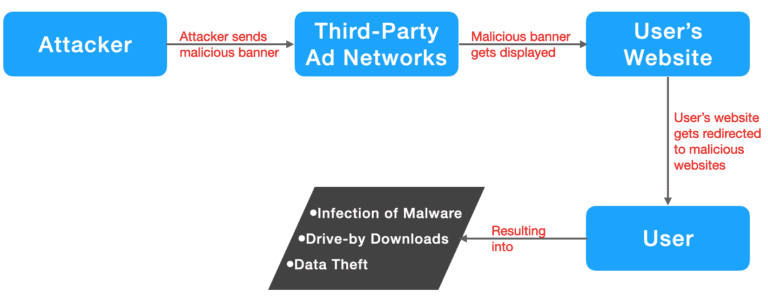Malvertising Attack: A Cybersecurity Threat Explained
“Malvertising” comes from a combination of “malware” and “advertising”, and includes taking advantage of online advertisements to spread malware or divert users to malicious websites. It is a type of cyber-attack that injects malicious code into legitimate-looking online advertisements of well-known online publications or even on social media. Believing these to be genuine sites, internet users either load the webpage or click on the ad, which downloads malware onto their devices.
Malvertising attack is a significant problem worldwide and has acquired increasing prevalence across the web.
How does malvertising work?
The typical strategy for malvertisers begins with purchasing ad space from publishing networks and submitting clean advertisements for a while to gain authenticity. After a few weeks, criminals switch their legitimate ads for ones infected with malware, which get communicated across any number of sites a publisher or network is working with.
These misleading ads can hamper a computer with malware attacks in two ways:
A pre-click malvertisement can be implanted in the main scripts of the page. They can start drive-by-download on visiting the malvertising-loaded site. A drive-by-download is a download in which a user does not need to click on any link and start the download. When a user visits the webpage, the malware begins downloading automatically in the background.
For a post click malvertisement, it infects a computer when a user clicks on the ad to see the advertisement and the user is redirected to a malware-infected website.

Effects of Malvertising Attacks :
Personal Data Theft
Financial Extortion
Types of Malvertising Attacks :
There are two main types of malvertising attacks that one should be aware of. Both include the use of ads to host malware, but their methods of releasing the malware vary.
Drive-by Download
A drive-by download is a method where a harmful software is downloaded onto a person’s computer without them interacting with the page. By simply loading the webpage, they succumb to the attack. In the case of malvertising attack, if a fraudulent ad has infected the page, a user’s device will be infected as soon as they load it.
Click to Download
Malvertising Attacks Example:
COVID-19 Attack
In 2020, Internet Explorer users were aimed at, in a COVID-19-related malvertising attack. In the midst of great stress and feeling of dread towards the pandemic, cybercriminals changed their malvertising campaigns to include a fake warning notification about COVID-19.
How to Prevent Malvertising Attacks:
Using a strong antivirus
Keep Software Up to Date
Install an Ad Blocker
Knowing how malvertising attacks work and the warning signs to look for can help provide sufficient shield to your data and devices.
Stay ahead of cyber threats. Contact us for a personalized cybersecurity consultation tod